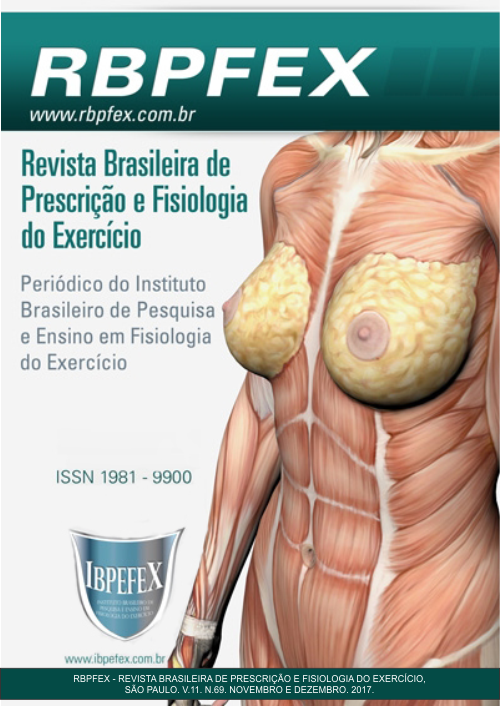Borg's scale achievement for non-athlete swimmers
Abstract
The swimming practice improves the cardiovascular function since the acute exercise variables, as intensity, are under control. The aim of this study was to verify the relationship between heart rate (HR) and rating of perceived exertion (RPE) in recreational adult swimmers as well as to test for significant sex differences. It 13 men and 11 women (mean age 30.04±3.95) who swam 5 x 50 meters using front crawl stroke of 70%, 77%, 84%, 93% and 100% of maximum speed. We measured average swimming speed (S), heart rate (HR) and ratings of perceived exertion (RPE) on each trial. Pearson product-moment correlations determined the relationship between the values of HR and RPE, S and HR, and S and RPE, while Student's t test compared differences on RPE between sexes (α < 0.05). Significant moderate relationships existed between RPE and HR (r=0.67) and between S and RPE (r=0.61). The relationship between S and HR (r=0.42) was low. We noted significant differences in S between males and females at all intensities (70% p=0.0006; 77% p=0.0003; 84% p=0.0002; 93% p=0.0005 and 100% p=0.0006) and in the RPE at 70% and 84% (p=0.047 e p=0.040 respectively) (p<0.05). The results indicated that the Borg RPE scale may serve as a accurate measure for determining swimming exercise intensity among recreational swimmers.
References
-American College of Sports Medicine. Position Stand on the recommended quantity and quality of exercising for developing and maintaining cardiorespiratory, musculoskeletal, and neuromotora fitness in apparently healthy adults: guidance for prescribing exercise. Medicine & Science in Sports & Exercise. Vol. 43. Num. 7. 2011. p. 1334-1359.
-Alberton, C. L.; Antunes, A. H; Pinto, S. S; Tartaruga, M. P; Silva, E. M.; Cadore, E. L.; Kruel, L. F. M. Correlation between rating of perceived exertion and physiological variables during the execution of stationary running in water at different cadences. Journal of Strength and Conditioning Research. Vol. 25. Num. 1. 2011. p. 155-162.
-Alberton, C. L.; Kruel, L. F. M. Influência da imersão nas respostas cardiorrespiratórias em repouso. Revista Brasileira de Medicina do Esporte. Vol. 15. Num. 3. 2009. p. 228-232.
-Borg, G. V. Borg’s perceived exertion and pain scales.Champaign. IL: Human Kinetics,. 1998.
-Borg, G. Escalas de Borg para a dor e o esforço percebido. São Paulo. Manole. 2000.
-Caputo, F.; Oliveira, M. F. M.; Denadai, B. S.; Greco, C. C. Fatores intrínsecos do custo energético da locomoção durante a natação. Revista Brasileira de Medicina do Esporte. Vol. 12. Núm. 6. 2006. p. 399-404.
-Graef, I. F; Kruel, L.F. M. Frequência cardíaca e percepção subjetiva do esforço no meio aquático: diferenças em relação ao meio terrestre e aplicações na prescrição do exercício: uma revisão. Revista Brasileira de Medicina do Esporte. Vol. 12. Num. 4. 2006. p. 221-228.
-Koltin, K. F.; O’connor, P. J.; Morgan, W. P. Perception of effort in female and male competitive swimmers. International Journal Sports Medicine. Vol. 12. Num. 4. 1991. p. 427-429.
-Kurokawa, T.; Ueda, T. Validity of ratings of perceived exertion as an index of exercise intensity in swimming training. The Annals Physiolgical Anthropology. Vol. 11. Num. 3. 1992. p. 277-288.
-Lima, M. C. S.; Junior, P. B.; Gobatto, C. A.; Junior, J. R. G.; Ribeiro, L. F. P. Proposta de teste incremental baseado na percepção subjetiva de esforço para determinação de limiares metabólicos e parâmetros mecânicos do nado livre. Revista Brasileira de Medicina do Esporte. Vol. 12. Num. 5. 2006. p. 268-274.
-Linnarsson, D. Dynamics of pulmonar gas Exchange and heart rate changes atstart and end of exercise. Acta Physiology Scandinavian. Vol. 415. Suplemmentum. 1974. p. 1-68.
-Maglisho, E. W. Nadando o mais rápido possível. São Paulo: Ed. Manole, 2010.
-Moraes, E.Z.C.; Kruel, L.F.M.; Sampedro, R.M.F.; Lopes, L.F.D. Metodologia de medida de esforço para exercícios de hidroginástica em diferentes profundidades de água. Revista Kinesis. Num. 27. 2002. p. 43-64.
-Müller, F. G.; Santos, E.; Tartaruga, L. P.; Lima, W. C.; Kruel,L. F. M. Comportamento da frequência cardíaca em indivíduos imersos em diferentes temperaturas de água. Revista Mineira de Educação Física. Vol. 9. Núm. 1. p. 7-23. 2001.
-Nakamura, F. Y.; Gancedo, M. R.; Silva, L. A.; Lima, J. R. P.; Kokubun, E. Utilização do esforço percebido na determinação da velocidade crítica em corrida aquática. Revista Brasileira de Medicina do Esporte. Vol. 11. Num. 1. 2005. p. 1-5.
-Psycharakis, S. G. A longitudinal analysis on the validity and reliability of ratingsof perceived exertion for elite swimmers. Journal of Strength and Conditioning Research. Vol. 25. Num. 2. 2011. p. 420-426.
-Shephard, R. J. PAR-Q, Canadian home fitness test and exercise screening alternatives. Sports Medicine. Vol. 5. Num 3. 1988. p. 185-195.
-Ueda, T.; Kurokawa, T. Relationships between perceived exertion and physiological variables during swimming. International Journal Sports Medicine. Vol. 16. Num. 6. 1995. p. 385-389.
-Wallace, L. K.; Slaterry, K. M.; Coutts, A. J. The ecological validity and application of the session-RPE method for quantifying training loads in swimming. Journal of Strength and Conditioning Research. Vol. 23. Num. 1. 2009. p. 33-38.
Authors who publish in this journal agree to the following terms:
- Authors retain the copyright and grant the journal the right of first publication, with work simultaneously licensed under the Creative Commons Attribution License BY-NC which allows the sharing of the work with acknowledgment of the authorship of the work and initial publication in this journal.
- Authors are authorized to enter into additional contracts separately for non-exclusive distribution of the version of the work published in this journal (eg, publishing in institutional repository or book chapter), with acknowledgment of authorship and initial publication in this journal.
- Authors are allowed and encouraged to post and distribute their work online (eg, in institutional repositories or on their personal page) at any point before or during the editorial process, as this can bring about productive change as well as increase impact and impact. citation of published work (See The Effect of Free Access).






